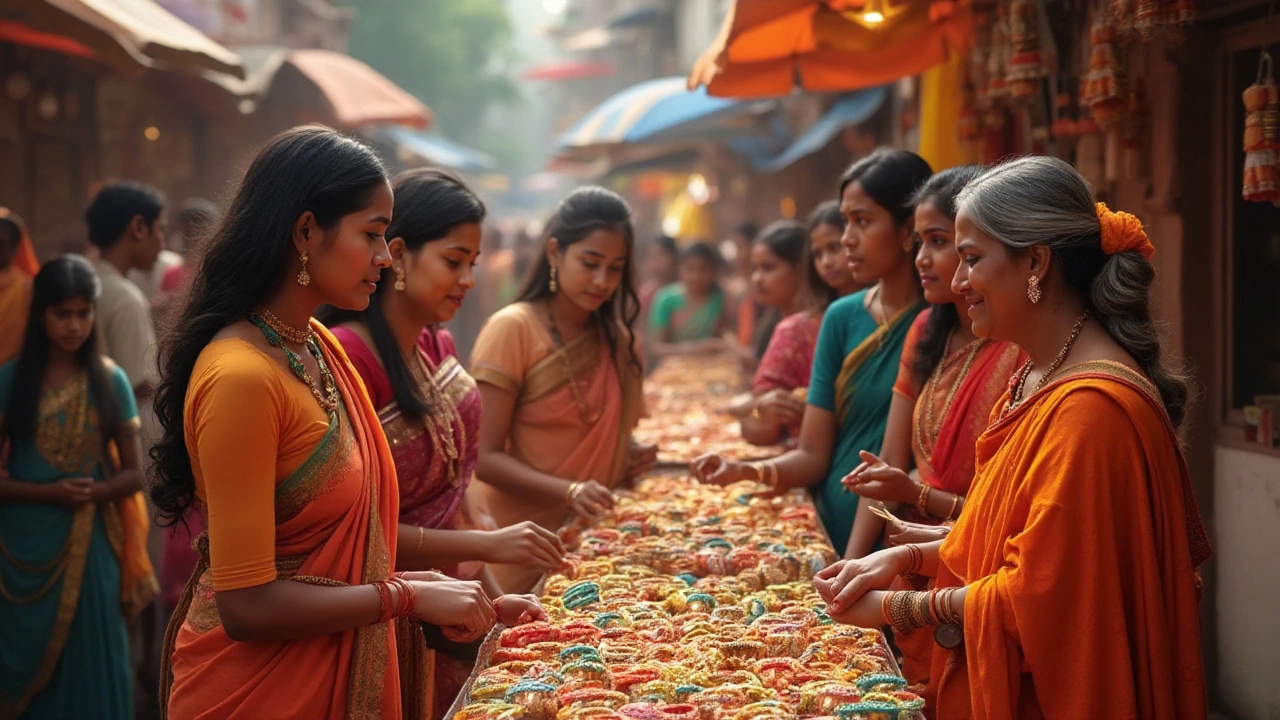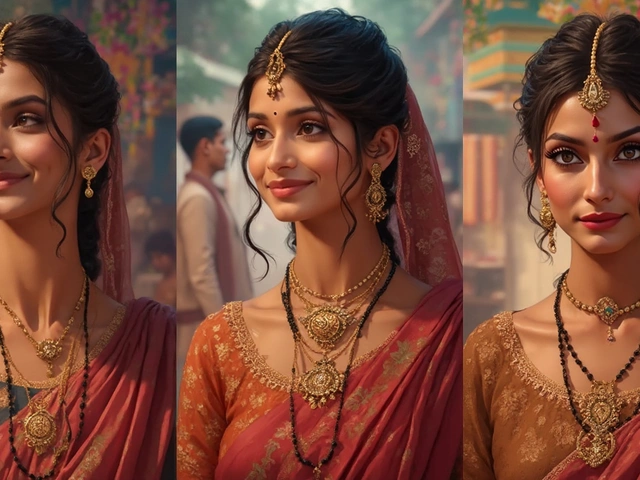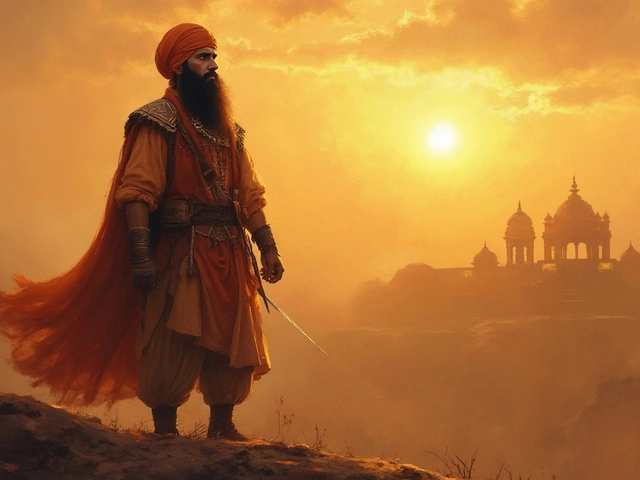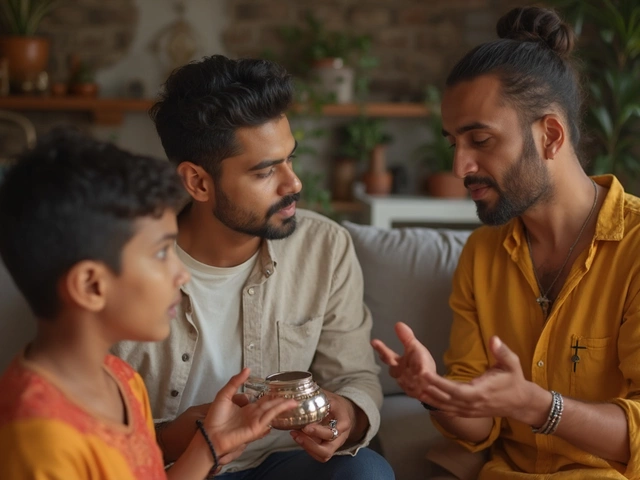Bangles, an ancient form of jewelry, have woven themselves into the cultural tapestry of India, carrying stories of tradition, fashion, and symbolism. Traditionally seen on the wrists of married women, bangles hold a unique place in Indian society, often associated with marriage and fidelity. However, their charm is not just limited to this aspect alone. Unmarried girls in India have also embraced this accessory, finding new ways to wear them that resonate with personal style and individual expression.
The appeal of bangles lies in their ability to add a splash of color and a hint of sophistication to any outfit. Today, young women and girls choose from a plethora of designs, materials, and colors, from the traditional glass and metal to contemporary plastic and rubber blends. This evolution of bangle fashion has been driven largely by a desire to blend tradition with modernity, allowing younger generations to celebrate their culture in a way that feels fresh and relevant.
Interestingly, the significance of bangles isn't rigid but rather flexible, adapting to personal narratives and lifestyles. For many, wearing bangles is about preserving heritage while playing with new fashion trends. This harmony of past and present truly captures the essence of young women adorning themselves with bangles, not just as a cultural artifact but as a statement of style and identity.
- The Cultural Significance of Bangles in India
- Bangles and Their Association with Marriage
- Popular Styles and Materials for Traditional Bangles
- The Evolution of Bangle Traditions Among Unmarried Women
- Fashion Trends: Mixing Tradition with Modernity
- Tips for Choosing and Styling Bangles for Unmarried Girls
The Cultural Significance of Bangles in India
In the vibrant tapestry of Indian culture, few adornments carry as much history and meaning as bangles. These circular bands, often crafted from an array of materials, have been worn for centuries, serving as a symbol of tradition, social status, and beauty. Historical texts and artifacts suggest that the tradition of wearing bangles dates back to ancient times, with evidence found in Mohenjo-Daro excavations, where a dancing girl statue adorned with bangles was unearthed. This link to ancient traditions provides a profound connection to the past that resonates with many wearers.
Bangles hold a particular allure due to their association with matrimonial status. In many Indian cultures, bangles symbolize auspiciousness and prosperity, marking the transition into married life. They are thought to bring luck and are considered essential at weddings, worn by brides as auspicious tokens. Often crafted in vibrant red or green, which are traditional colors of prosperity and fertility, these bangles accompany a woman into her new home, signifying her status as a wife. Yet, this does not hinder unmarried women from donning these elegant ornaments. Instead, it adds layers of expression and personal meaning, adapting with modern sensibilities.
The choice of materials in bangle crafting is as diverse as the Indian culture itself. Traditional materials like glass, gold, and lac have given way to more modern interpretations, including plastic and metal variations that cater to contemporary tastes. In regions like Rajasthan and Gujarat, gold bangles are a sign of wealth and are often passed down through generations as heirlooms. This transformation of materials signifies how cultural practices evolve while maintaining a foothold in deeply ingrained traditions. Renowned jewelry designer, Sabyasachi Mukherjee once stated,
"Jewelry is the most transformative thing you can wear. It lifts you up in a second and is a heritage that carries forward stories of generations."
Across the varied landscapes of India, the style and significance of bangles shift. In coastal regions like Tamil Nadu and Kerala, heavier and wider designs are dominant, reflecting the area's robust maritime heritage, while in Northern India, delicate glass bangles are prized for their delicate sound and intricate design. Community festivals and regional celebrations further underscore the diversity in styles, making bangles a staple across cultural celebrations, not just a matrimonial accessory.
Significantly, many young unmarried girls in India today are redefining the way bangles are perceived by choosing them as daily wear prom souvenirs of culture. They have taken an ornamental icon from their ancestry and infused it into daily wear items that resonate with contemporary life. A recent survey illustrated that about 60% of teenage girls in urban India own at least five different styles of bangles, ranging from traditional designs to modern minimalist ones, demonstrating their ongoing relevance in modern fashion.
As these traditions continue to evolve, bangles remain a potent symbol of identity and cultural heritage. Whether they are worn to honor familial ties, as fashion statement, or as engagements with an ancient past, bangles tell stories that are both personal and collective. Their importance in social customs and individual expression highlights the incredible journey they have traveled through time, uniting tradition with personal flair in the modern world.
Bangles and Their Association with Marriage
Bangles in Indian culture are more than just decorative accessories; they are a tradition steeped in history, particularly linked to the institution of marriage. The practice dates back centuries, potentially to the Indus Valley Civilization, where ancient figurines adorned with bangles have been discovered. For married women, especially in regions like Punjab and Bengal, the wearing of *bangles* holds auspicious meanings, symbolizing marital status and wishing for the long life of their husbands. Traditionally, these bangles are gifted during wedding ceremonies and are expected to be worn throughout matrimony.
In specific cultural pockets, different materials and colors signify various aspects of life and commitment. Glass bangles, known for their fragile beauty, represent the vulnerability and endurance within a marriage. Red, a common color for bridal bangles, often signifies prosperity and fertility, while green is associated with growth and harmony. In South India, gold bangles are preferred for their lasting nature and auspicious associations. These cultural beliefs are deeply interwoven with the identity and status of a married woman, marking her transition from a daughter's home to her marital life.
The Rituals Surrounding Bangles
One of the most celebrated rituals involving bangles is the *bangle ceremony*—an auspicious event held for the bride before her wedding day. During this time, family members present her with sets of bangles, each reflecting warmth and blessings for her new journey. Often, the sound of bangles clinking is poetically referred to as music that resonates with love and happiness gleaming through the new phase of a woman's life. Apart from marriage, bangles play a pivotal role in festive and religious occasions, further knitting them into the tapestry of life's significant events.
The renowned author Nirad C. Chaudhuri once wrote about the vibrant tapestry of Indian culture: "The sound of a woman's bangles is akin to the gentle whisper of tradition, echoing tales of joy, love, and familial bond across generations."
The metallic clink of bangles not only carries these narratives but also plays a part in the social rituals observed through Indian households. It's not uncommon to see mothers-in-law present bangles to their daughters-in-law as a symbolic gesture of acceptance and love. And while these traditional roles remain emphasized, there's a growing trend among *unmarried girls* to adopt these bangles—not as symbols of martial status, but as expressions of personal style and cultural homage.
- Beliefs and customs vary widely across the Indian subcontinent, influencing how bangles are worn and perceived.
- In some traditions, married women believe that if her bangle snaps, it is a call to action—often interpreted as a need to address domestic well-being.
- Conversely, younger generations focus more on the aesthetics and fashion appeal of bangles, opting for eclectic mixes of colors and materials.
- This evolution symbolizes a larger cultural shift where tradition and modernity coexist, celebrating individuality over prescriptive norms.
The regional diversity and symbolism surrounding bangles offer a fascinating glimpse into the mosaic of Indian traditions. While they have traditionally celebrated the sanctity of matrimony, the continuing trends see *unmarried girls* embracing bangles for their style and cultural resonance. These shifts reflect broader cultural transitions, where tradition meets the exuberance of youthful expression, highlighting the enduring charm that bangles bring to the wrists of their wearers.
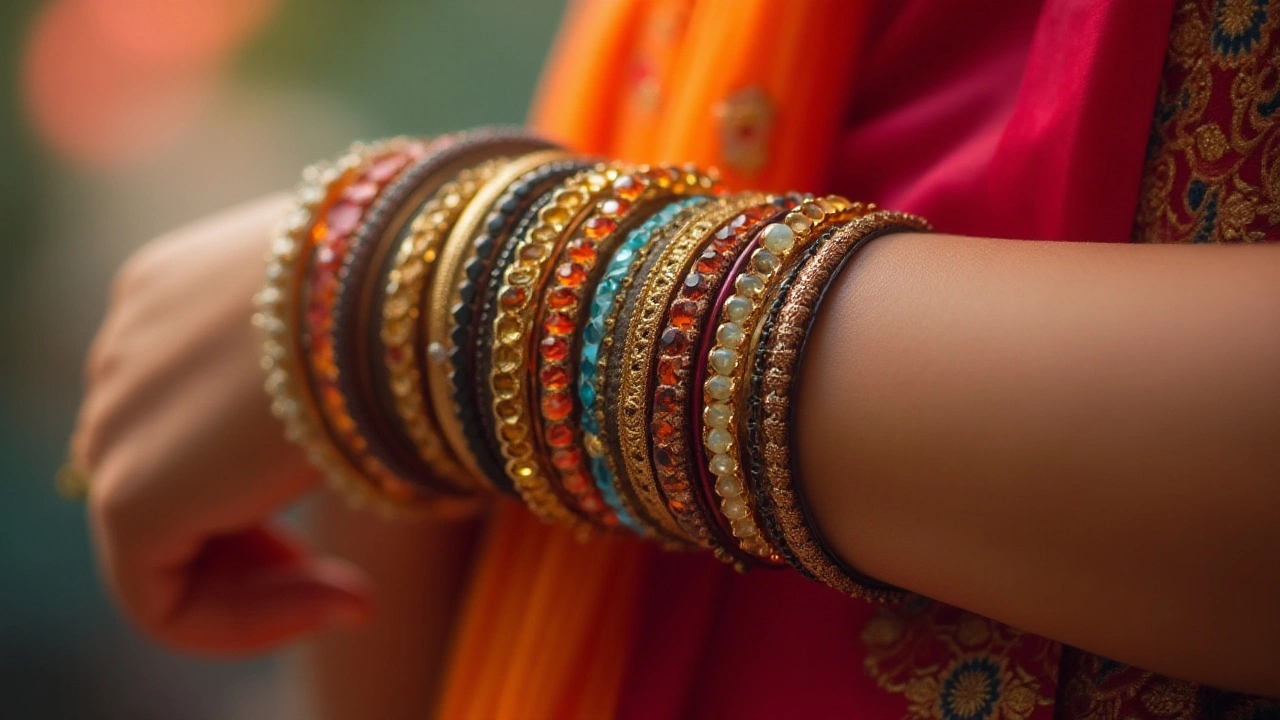
Popular Styles and Materials for Traditional Bangles
Traditional bangles are much more than just adornments; they are vessels of culture, art, and history. These alluring bracelets come in an array of styles and materials, each with its own story to tell. For instance, in Northern India, glass bangles are highly sought after during weddings and festivals. The clinking sound of these bangles is considered music to the ears, believed to bring peace and prosperity. Made through a meticulous process of heating and molding glass, these bangles are often found in vibrant colors and intricate designs, mirroring the exuberance of festivities.
Another popular choice is metal bangles, which range from delicate gold and silver bands to the heavier, more ornate versions studded with stones and intricate filigree work. In South India, gold bangles are particularly cherished as they are considered a symbol of wealth and status. These pieces often become family heirlooms, passed down through generations. A famous variant includes 'Kada' or thick bangles, which are often engraved with symbolic motifs or religious inscriptions.
Bangles crafted from lac, a natural resin secreted by insects, are also quite popular, especially in the states of Rajasthan and Gujarat. Known for their vibrant hues and dazzling embellishments, lac bangles come adorned with glittering stones and are known for their eye-catching appeal. Speaking of eye-catchers, stone-studded bangles and those adorned with pearls or crystals are favored for adding a touch of luxury and glamour to traditional attire.
In recent years, the material preferences have expanded to include unconventional choices such as plastic, rubber, and even wood. These are favored not only for their affordability but also for the flexibility they offer in terms of colors and patterns. As younger generations seek to break away from conventions, these materials allow for creative and personalized fashion statements. Some designers are even experimenting with eco-friendly materials, crafting exquisite bangles out of recycled items.
With such an impressive range of traditional bangles, it's evident that their charm lies in their versatility and the ability to transcend cultural boundaries. As the fashion industry evolves, so do styles and materials, inviting innovation while respecting tradition. According to renowned jewelry designer Sabyasachi Mukherjee,
Bangles are not just ornaments. They are carriers of tradition, yet they adapt to current trends with surprising grace.Such insights reflect the timeless appeal of these stunning accessories, forever ingrained in the cultural fabric of India.
The Evolution of Bangle Traditions Among Unmarried Women
Bangles in India have a long and intricate history that extends far beyond their aesthetic appeal. Traditionally, unmarried girls in India might have viewed bangles solely as a decorative accessory, distinct from the marital connotations they carry among married women. Over time, however, these exquisite wristbands have evolved into a tapestry of personal expression for young women, intertwining age-old traditions with the spirit of modern dynamism.
In many Indian cultures, bangles have historically signified a woman’s marital status with materials often chosen to convey prosperity and happiness. For unmarried girls, wearing bangles frequently symbolizes grace, music in every gesture, and even auspiciousness. As these young women step confidently into roles shaped by a modern society, they have embraced bangles as a versatile fashion statement. The cultural fabric of India thrives on its vivid colors and rich customs, making bangles an exciting canvas for blending old with new—a story told through every piece of glass or metal on their wrists.
One might think of the village fairs and bustling city markets where traditional bangles shimmer in the sunlight, hanging in clusters and waiting to be chosen for their intended bearer. Here, history and innovation converge, allowing the younger generation to adopt, adapt, and at times, reinvent the significance of these circular wonders. The allure of bangles has surged, pushing beyond the confines of tradition into the realms of high fashion. Young women today use bangles to make statements about their personalities, tastes, and aspirations.
This transformation has sparked a resurgence of interest among fashion designers, prompting them to explore new designs that cater to the evolving preferences of unmarried girls. Glass bangles, once considered fragile, are now a vibrant symbol of resilience, available in an array of colors, patterns, and finishes that appeal to a global audience. In their quest to marry tradition with contemporary chic, these designers revisit classic motifs with a modern twist.
Artists and connoisseurs may remember the old bazaars where bangles were sold by the dozen, each piece carrying its own unique charm and story. Yet, there’s a beauty in the new direction these ornaments have taken. As young women select bangles, they reflect their own narratives, choosing pieces that speak to their individual styles while paying homage to the customs of their ancestors. Bangles have effectively transitioned from being a mere cultural obligation to a vital accessory that complements the varied lifestyles of today’s youth.
"The bangle is so much more than jewelry; it is both history and future intertwined in a circle," shares renowned Indian fashion designer Anita Dongre, summing up the symbolic metamorphosis.
The embracing of bangles by unmarried girls is not simply about following a trend, but about connecting with a heritage that is an essential part of their identity. The durability of metal, the fragility of glass, and the warmth of wood—each bangle tells a story of heritage, modernity, and self-expression, making waves in cultural and fashion narratives alike.
Indian culture, known for its vibrancy and diversity, finds a reflection in the way these young women wear their bangles, often mixing and matching them to create kaleidoscopic arm decorations that effortlessly blend with Western outfits or traditional attire. By doing this, they break barriers, redefine old customs, and carve out a niche where tradition and style coalesce seamlessly. The future of bangle traditions seems bright, full of possibility, and defined by the multifaceted women who proudly wear them today.
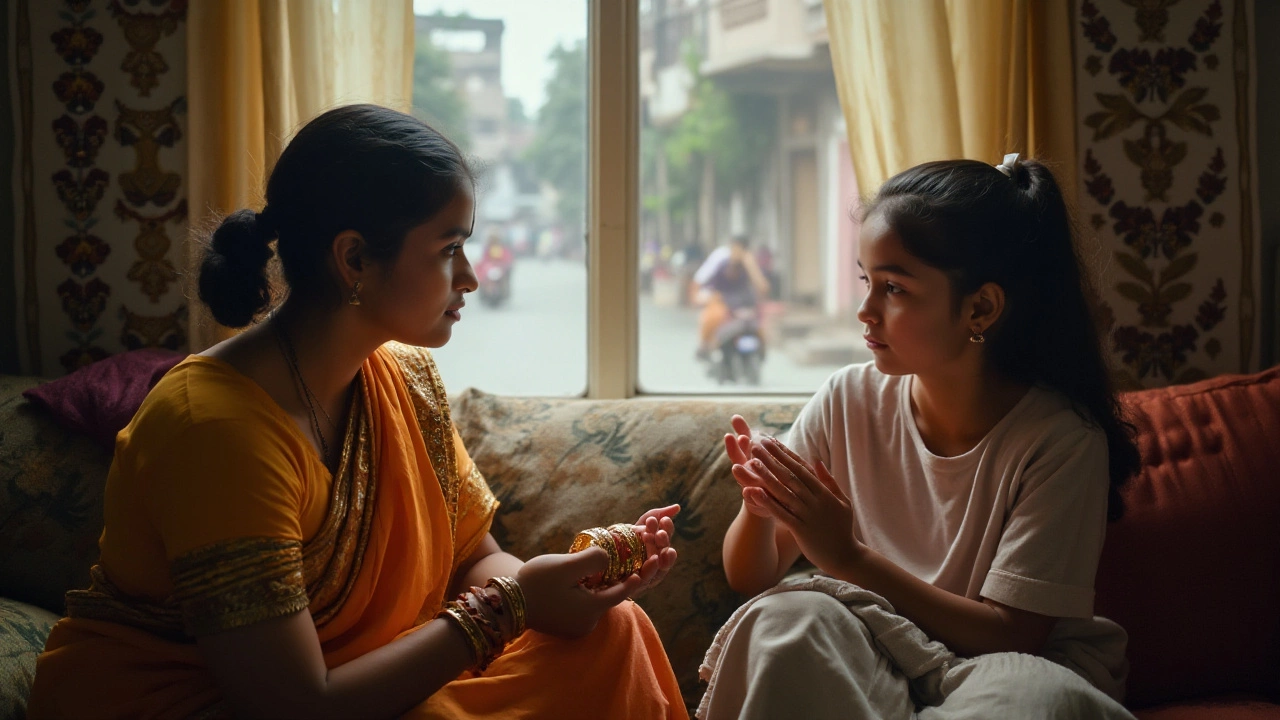
Fashion Trends: Mixing Tradition with Modernity
The world of fashion is ever-evolving, yet it consistently returns to its roots for inspiration. One of the most intriguing trends of recent times is how modern fashion effortlessly weaves traditional elements into contemporary styles. The story of traditional bangles in India is a perfect example of this synergy. Today, bangles are no longer just a sign of marital status but are also exquisite fashion statements embraced by women of all ages. They symbolize a bridge between the rich historical past and the vibrant present.
Across the urban landscapes of India, young fashionistas are redefining how bangles are worn. These unmarried girls prefer experimenting with an eclectic mix, where classic designs are paired with innovative accents such as fresh colors, varied materials, and unconventional shapes. For instance, combining the delicate jangle of glass bangles with the boldness of metallic cuffs is a popular trend, offering endless choices to enhance any outfit, from casual streetwear to spectacular evening ensembles.
The resurgence of interest in ethnic wear and traditional accessories in global fashion circles has also influenced this trend. Designers often speak of the thrilling possibilities that the infusion of local crafts into modern fashion provides. As the celebrated Indian designer Sabyasachi Mukherjee once said,
"Fashion is about storytelling, it’s not just about what you wear but how it makes you feel."This sentiment resonates with the present generation that adores self-expression through vivid personal styles, including their choice in bangles. By opting for such combinations, young women effectively highlight their appreciation for heritage while showcasing their flair for modern aesthetics.
Adapting Indian culture to contemporary fashion isn't just about mixing old with the new; it’s about creating something fresh and relatable. Consider the global phenomenon of fusion jewelry, where traditional motifs are reimagined in modern settings, like pairing kundan designs with minimalist bangles or incorporating leather and other materials into classical themes. Many fashion blogs and runways now proudly showcase these blends, ensuring that the elegance of yesteryears finds its rightful place in the wardrobes of today’s fashion-forward.
This creative confluence has not only made traditional jewelry like bangles more accessible but also celebrates the artisans who keep these ancient crafts alive. It’s an ecosystem where tradition inspires innovation, offering endless possibilities for those looking to carve out a niche in the fashion world. Young women worldwide, inspired by these changes, are increasingly adopting these styles, thus keeping the legacy of their heritage relevant without losing the freshness and vitality demanded by modern aesthetics.
Tips for Choosing and Styling Bangles for Unmarried Girls
When it comes to selecting traditional bangles for unmarried girls, the possibilities are as expansive as the rainbow of colors they come in. A key tip for choosing these beautiful pieces is to consider the occasion. Casual events might call for lightweight and colorful bangles, while more formal settings can be the perfect opportunity to showcase intricate designs crafted from precious metals. It's important to strike a balance that complements both the attire and the essence of the event. Matching bangles to one's outfit can enhance the overall look, but a contrasting set can create a bold fashion statement that reflects one's modern personality.
Materials are another vital factor in selection. Traditional glass bangles are beloved for their classic, tinkling sound and vibrant sheen, but alternate materials like gold, silver, or modern acrylic offer durability and distinct style. Younger women often lean towards eclectic styles that incorporate unconventional materials, allowing them to experiment while still embracing their cultural roots. Additionally, mixed material bangles can serve as a bridge between traditional aesthetics and contemporary fashion. Ultimately, the choice of material should echo the wearer's comfort and personal style preference. Bangles can be layered or worn singular, depending on the intended fashion statement, giving numerous options for creativity.
Styling bangles involves thoughtful layering and pairing. A single strand of elegant bangles can achieve a subtle and sophisticated look, while stacking multiple sets creates a vibrant and eye-catching appeal. It's all about mixing textures, colors, and sizes. For example, you can combine slender bangles with chunkier ones to create an interesting juxtaposition, or play with a palette of similar colors for a harmonious blend. Leveraging trends such as white and gold combinations or black and metallic pairings can bring a modern twist to traditional pieces. Careful attention to how they fit around the wrist is crucial as comfort should never be compromised for style.
"Bangles are more than mere accessories; they are a testament to a woman's personality and heritage," says renowned Indian fashion designer Sabyasachi Mukherjee. His sentiments highlight the rich narrative that bangles have in a woman's wardrobe.
In exploring the market, take note of local artisans who craft unique designs. These craftsmen often bring a personal touch to each piece, ensuring it can't be found elsewhere. Custom-made bangles are gaining popularity, especially those personalized with engravings or charms, making them truly one-of-a-kind. This not only supports local craftsmanship but also adds a layer of meaning to the jewelry. Visiting markets rich in cultural heritage can render a glimpse into varied designs and styles that resonate with personal stories and family traditions, offering a connection to one's roots.
Finally, versatility is key to styling bangles elegantly. They should be able to transition seamlessly from daywear to evening glam. Pairing them with other jewelry pieces like rings, necklaces, or earrings should be done thoughtfully, avoiding overwhelming the ensemble. Remember, balance is essential to highlighting the beauty of each individual accessory, so aim to create a complementary look that radiates both tradition and modern flair. Whether blending ethnic with chic or traditional with the avant-garde, bangles embody a fashionable expression that speaks volumes without words.
